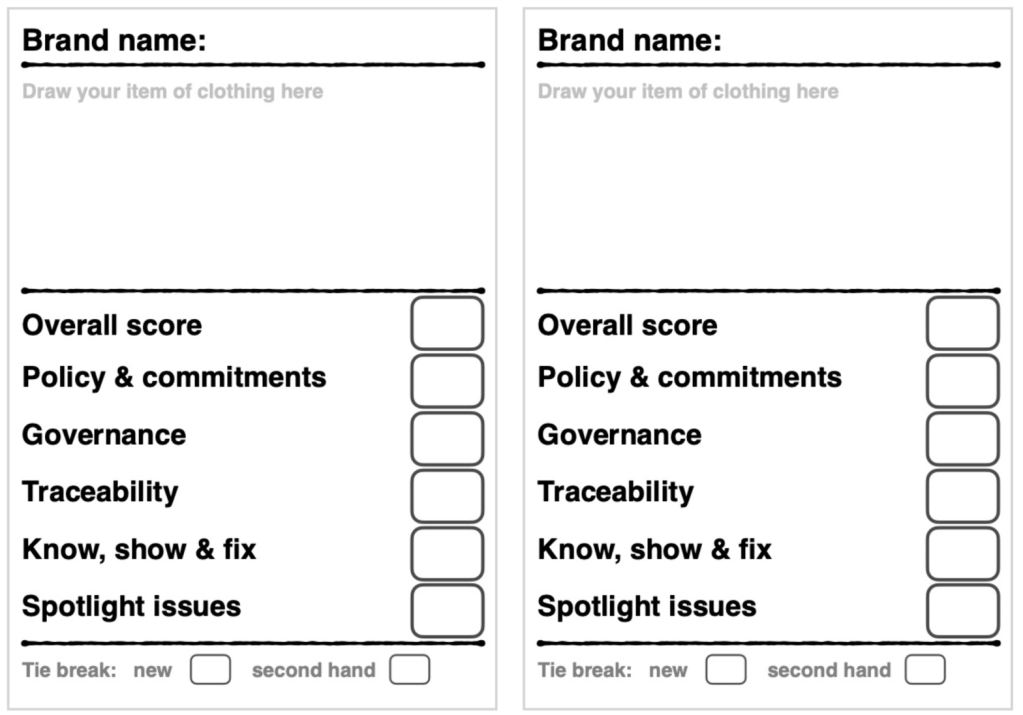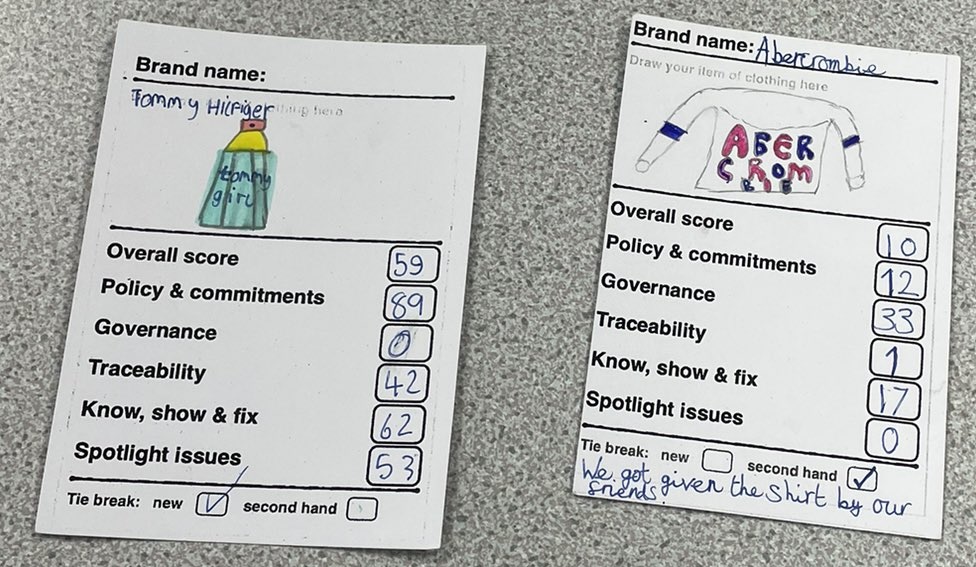
followthethings.com
Back to school
“Fashion Transparency Trump Card Game“
A card game developed by Ian Cook et al for originally for the Fashion Revolution (2014) and Fashion Revolution Brazil (2020)
Fashion Revolution Brazil’s instagram game video & YouTube Programa Educacional Jovens Revolucionários video embedded above. Resources available below. This page is an edited and updated version of posts originally published on the followthethings.com blog here.
When trade justice organisations produce numerical data about corporations’ ethical, sustainability or transparency there’s an opportunity to make this data accessible to students in the form of a Trump Card game that they can make and play with their own possessions. The initial idea for this game came from students taking the ‘Geographies of Material Culture’ module that’s behind the followthethings.com website (see our demo cards here and some cards made and played by students at Bath Spa University here). What’s presented below are a set of blank cards and an ongoing, updated set of data that your students could work with now. This game is an excellent ice-breaking activity to engage students in discussions of the pay and conditions of the people who make their clothes. It’s also a good way to encourage discussion of the terms that are being played with (what’s good ‘governance’ for example?) and to appreciate how corporations can and do make different amounts of effort to create a more ethical and sustainable economy (with limits). This game can be made and played by any group of people trying to learn the basics and/or intricacies of Ethical Trade and Corporate Social Responsibility.
Page reference: Ian Cook et al (2025) Fashion Transparency Trump Card Game. followthethings.com/fashion-transparency-trump-card-game.shtml (last accessed <insert date here>)
Estimated reading time: 15 minutes.
a) watch an introduction to the ‘Top Trumps’ game
This game assumes that its players have some familiarily with a commercial card called ‘Top Trumps’ in the English Speaking world. You buy a pack about dogs, skyscrapers, dinosaurs or sports cars and play them off against one another: which dinosaur has the higheest ‘killer rating’? Your card or my card? The winner keeps all the cards for that round. The winner then looks at their next card, guesses which category they might win on this time, calls out ‘Intelligence: 9’ and hopes for the best. And repeat until time is up (the player with the most cards wins) or one player has won all of the cards. Whatever happens, the players will have learned perhaps otherwise quite boring facts about Dinosaurs in an entertaining game format.
b) watch an introduction to the concept of ‘transparency’
c) download a blank ‘Fashion Transparency’ trump card template

d) check the latest Fashion Revolution Fashion Transparency Index
This is where you ask your students to look through a detailed report by the Fashion Revolution movent to find the information they need to complete their cards. Historically, Fashion Revolution had scores fashion brands in the six ways outlined on the blank cards (NB they tried a different approach in 2024). We’ve embedded their 2023 report below to explain where the information needed for this game can be found and added to the cards.
NB. You can find the latest Fashion Transparency Index reports, including those for Brazil and Mexico, here.
e) ask students to find their clothing brands in the report
In recent years, these reports have featured 250 brands. Students can look up the brands of their favourite items of clothes, the ones they’re wearing at the moment, the ones they wore at the weekend, on the list on page 35.
f) ask students make a card for an item of their own clothing
They have chosen a clothing brand that they own that is also featured in the report. Now it’s time to write the name of the brand on a card and to drawn that item of clothing underneath.
Then, they can then add the brand’s scores to the card for ‘overall’ (taken from page 45 of the 2023 report) ‘policy and commitments’ (from page 50), ‘Governance’ (from page 58), ‘Traceability’ (from page 64), ‘Know, show and fix’ (from page 78), and ‘Spotlight issues’ (from page 86).
NB the ‘spotlight issues’ change from, year to year.
There is also a ‘tie break’ question: ask the students to tick whether their item of clothing was bought new for them, or is second hand.
The completed cards should look like this:

NB nobody should know whose cards are whose (except when you see your own card being played). Nobody knows which card will win and lose each time (but they may learn!). It’s importang to be sensitive to students who may not own branded clothing due to tight family finances or other reasons. Find a way to enable everyone to make a card and be involved in the game.
g) assemble the pack and play the game
Students can make one or more cards depending on the size of your class. As soon as enough cards have been made (perhaps 20 – 30), assemble them into one pack, shuffle and deal them to three or four representatives from the class in a rabble-rousing tournament atmosphere and get the game started.
Choose a player one. Ask them to choose a category from the card at the top of their pile which they think has a high score (e.g. if it was the Tommy Hilfiger card above, they might choose ‘policy & commitments’ because of its 89 score). Ask them to slap that card on the table, say the brand name – “Tommy Hilfiger” – the category they have chosen – “Policy & commitments” – and its score – “89”. Then ask player two to slap the card at the top of their pile on the table, say its brand name – “Abercrombie” – the category chosen by player one – “Policy & commitments” – and their card’s score – “12”. Player three and player four follow suit. Then, the player whose brand’s “Policy & commitments” score is highest wins the round and gets to keep all of the cards played. They place these at the bottom of their card pile and play their next card. They slap it on the table, say its brabnd name, choose the category they think may be a winner, shout out the score, and the next round continues. Encourage the students watching to cheer and groan as they wish (like the players in the video above).
If there’s a tie in a round – e.g. two or more cards have 89 as their ‘policy & commitments’ score – go to the tiebreak question: is that item of clothing new or second hand. If the answer is the same for both, ask player one to play another card and start the round again. If the answers are different – one is new, the other is second hand – ask the class which card should win.
The game can finish when one player has won all of the cards or after a set period – maybe five or ten minutes – when you can count how many cards each player has ended up with.
h) the discussion begins!
After the game ended, we discussed what had happened, why some cards were worse to play that others, why – with one exception – the policy grades were higher than the ‘workers’ rights’ grades, and how to find out why by looking at brands’ … ‘score cards’. So, 40 minutes into class, we were talking about, asking informed questions about, and having a good idea how to find out more about the relations between ethical trade policies, transparency, monitoring, workers’ rights and the Accord.
Match report from 2014
After a few rounds, players might start to ask what the categories actually mean. What’s being measured and how? You will need to have read parts of the report to be able to provide the answers, feed them back into the game play. When the game starts to click, it can becomea kind of thrilling, hands-on data play, that’s entertainingly depressing and can develop and question – in fine-tuned ways – players’ stereotypical ideas of ‘good’ versus ‘bad’ fashion brands.
Depending on the level of detail that you want to get into from the report, the discussion can move in different directions. One thing we have noticed playing this game, for example, is that brands’ ‘policy & commitments’ scores seem to be higher than their ‘Know, show & fix’ scores, which means that they could be promising more on paper that they do in practice.
One a deeper level, you could steer the discussion of how individual brand’s scores have change since the Fashion Transparency Index as first published in 2017. All of the reports are avalable online if you wish to research this. It’s important for students to appreciate that supply chain relations can change for the better and that they can thet can play a part in keepng up the pressure.
Fashion Revolution’s mantra is ‘Be Curious. Find Out. Do Something.’ Making and playing this game has involved being curious about their own clothes and finding something out about them (and the fashion industry as a whole). So, what do they think they could do next?
PS Fashion Revolution Brazil’s Programa Educacional Jovens Revolucionários
A Portuguese version of this game – called Jogo da transparência – was published in 2020 by Fashion Revolution Brazil. followthethings.com’s CEO Ian was invited to Sao Paulo to give a talk about Fashion Revolution’s ‘who made my clothes’ approach to teaching and learning,1 and to participate in a workshop to create new teaching and learning resources for Brazilian learners.
This trump card game, and a number of other ‘who made my clothes’ education resources were prototyped here by and for Brazilian educators and students, test-driven in educator workshops around the country and published in the book embedded below. Even if you don’t read Portuguese and have to use Google Translate, these are some fascinating and powerful resources to experiment with here.
This pack is based on an Ethical Trade Trumps pack designed by Ian Cook for followthethings,com, in consultation with the #followheteachers ‘user crew’ Alan Parkinson, Oprah Whipp, Victoria Salt, Charlotte Wild, Jenny Thomas, Natalie Batten, Heather Taylor and Mary Buddulph. This page was written by Ian Cook (last updated January 2025).
1Ian was Fashion Revolution’s ‘Global Education & Resources Lead’ (2014-2016), is a member of its ‘Global Education Group’ (2020-), and was a consultation committee member for its first Fashion Trasparency Index.
![]()
